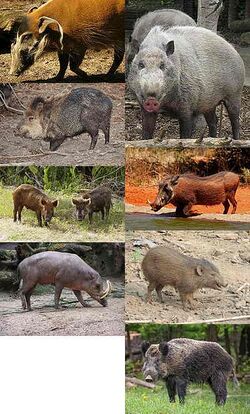Biology:Suina
| Suina | |
|---|---|

| |
| Scientific classification | |
| Script error: No such module "Taxobox ranks".: | Animalia |
| Script error: No such module "Taxobox ranks".: | Chordata |
| Script error: No such module "Taxobox ranks".: | Mammalia |
| Script error: No such module "Taxobox ranks".: | Artiodactyla |
| Script error: No such module "Taxobox ranks".: | Artiofabula |
| Script error: No such module "Taxobox ranks".: | Suina Gray, 1868 |
| Genera and families | |
| |
Suina (also known as Suiformes) is a suborder of omnivorous, non-ruminant artiodactyl mammals that includes the domestic pig and peccaries. A member of this clade is known as a suine. Suina includes the family Suidae, termed suids, known in English as pigs or swine, as well as the family Tayassuidae, termed tayassuids or peccaries. Suines are largely native to Africa, South America, and Southeast Asia, with the exception of the wild boar, which is additionally native to Europe and Asia and introduced to North America and Australasia, including widespread use in farming of the domestic pig subspecies. Suines range in size from the 55 cm (22 in) long pygmy hog to the 210 cm (83 in) long giant forest hog, and are primarily found in forest, shrubland, and grassland biomes, though some can be found in deserts, wetlands, or coastal regions. Most species do not have population estimates, though approximately two billion domestic pigs are used in farming, while several species are considered endangered or critically endangered with populations as low as 100. One species, Heude's pig, is considered by the International Union for Conservation of Nature to have gone extinct in the 20th century.
Classification
Suina's placement within Artiodactyla can be represented in the following cladogram:[1][2][3][4][5]
| Artiodactyla |
| ||||||||||||||||||||||||
The suborder Suina consists of 21 extant species in nine genera. These are split between the Suidae family, containing 18 species belonging to 6 genera, and the Tayassuidae family, containing 3 species in 3 genera. This does not include hybrid species such as boar–pig hybrids or extinct prehistoric species. Additionally, one species, Heude's pig, went extinct in the 20th century.
- Family Suidae (Pigs)
- Genus Babyrousa: four species
- Genus Hylochoerus: one species
- Genus Phacochoerus: two species
- Genus Porcula: one species
- Genus Potamochoerus: two species
- Genus Sus: nine species
- Family Tayassuidae (Peccaries)
|
References
- ↑ Beck, N.R. (2006). "A higher-level MRP supertree of placental mammals". BMC Evol Biol 6: 93. doi:10.1186/1471-2148-6-93. PMID 17101039.
- ↑ O'Leary, M.A.; Bloch, J.I.; Flynn, J.J.; Gaudin, T.J.; Giallombardo, A.; Giannini, N.P.; Goldberg, S.L.; Kraatz, B.P. et al. (2013). "The Placental Mammal Ancestor and the Post-K-Pg Radiation of Placentals". Science 339 (6120): 662–667. doi:10.1126/science.1229237. PMID 23393258. Bibcode: 2013Sci...339..662O.
- ↑ Song, S.; Liu, L.; Edwards, S.V.; Wu, S. (2012). "Resolving conflict in eutherian mammal phylogeny using phylogenomics and the multispecies coalescent model". Proceedings of the National Academy of Sciences 109 (37): 14942–14947. doi:10.1073/pnas.1211733109. PMID 22930817. Bibcode: 2012PNAS..10914942S.
- ↑ dos Reis, M.; Inoue, J.; Hasegawa, M.; Asher, R.J.; Donoghue, P.C.J.; Yang, Z. (2012). "Phylogenomic datasets provide both precision and accuracy in estimating the timescale of placental mammal phylogeny". Proceedings of the Royal Society B: Biological Sciences 279 (1742): 3491–3500. doi:10.1098/rspb.2012.0683. PMID 22628470.
- ↑ Upham, N.S.; Esselstyn, J.A.; Jetz, W. (2019). "Inferring the mammal tree: Species-level sets of phylogenies for questions in ecology, evolution, and conservation". PLOS Biology 17 (12): e3000494. doi:10.1371/journal.pbio.3000494. PMID 31800571.(see e.g. Fig S10)
Wikidata ☰ Q335308 entry
 |
